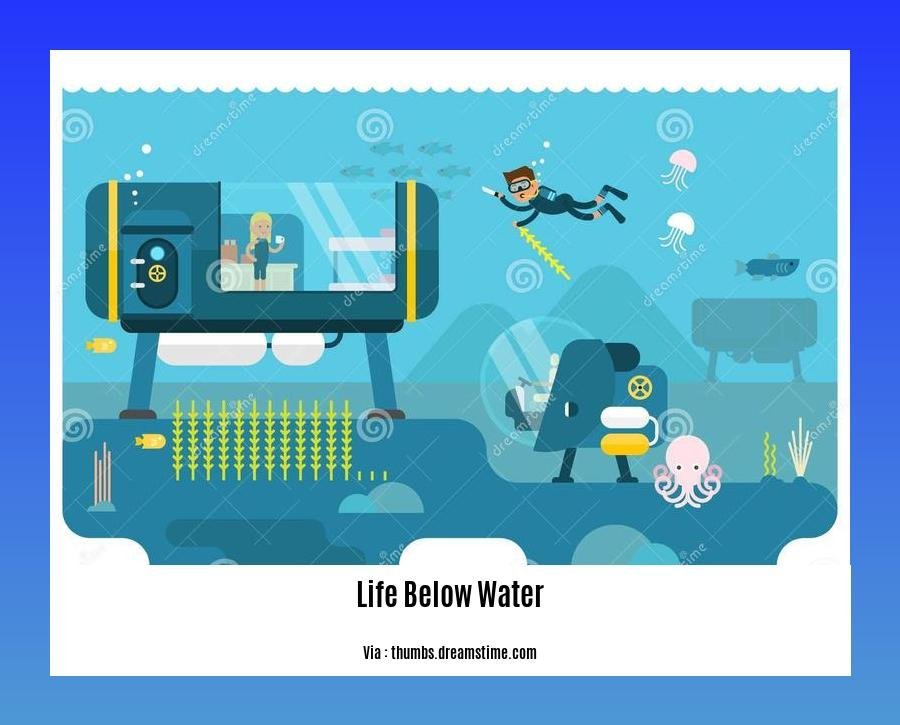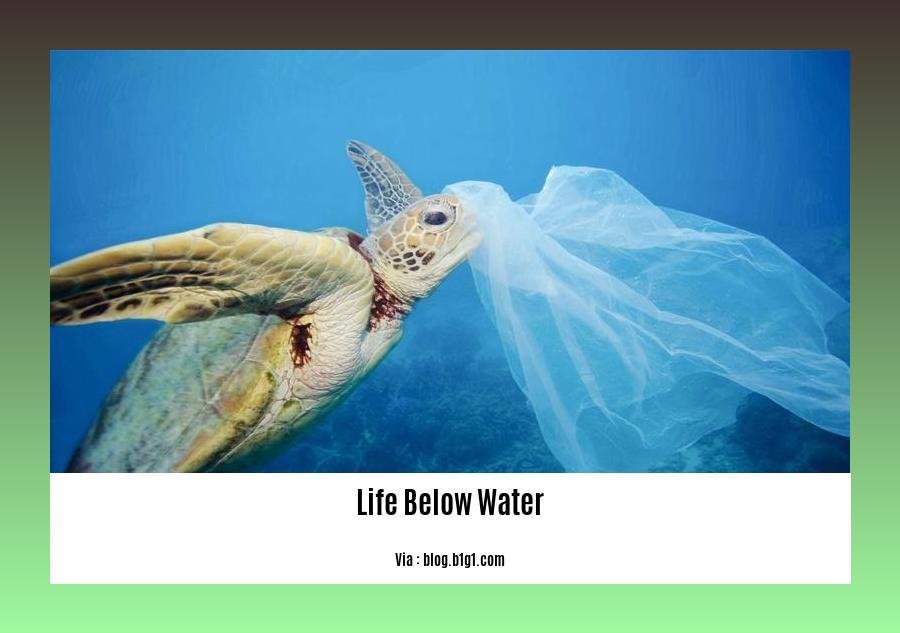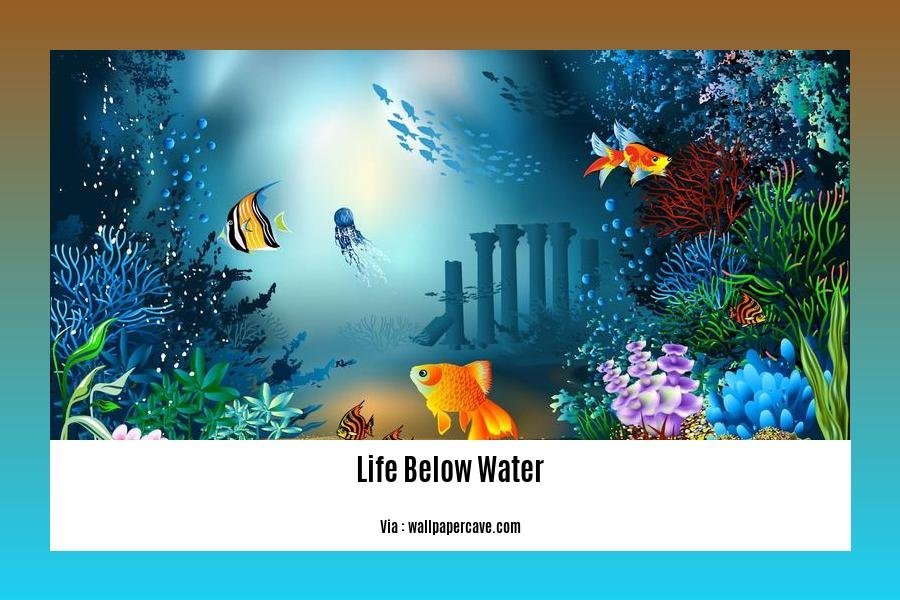Unveiling the Secrets: Fascinating Facts About Life Below Water
Explore the astonishing world beneath the ocean’s surface as we delve into the hidden marvels and captivating wonders that lie within. In this article, we will unveil the secrets of life below water, shedding light on the incredible facts that make our underwater ecosystems so enchanting and vital. From mesmerizing adaptations of marine species to the delicate balance of their interconnected habitats, join us on a journey to appreciate, protect, and conserve the breathtaking beauty that thrives beneath the waves. Prepare to be amazed by the fascinating facts that await as we dive into the depths of our invaluable oceans.
Key Takeaways:
- Marine fisheries employ over 200 million people worldwide.
- The proportion of fish stocks within sustainable levels has decreased from 90% to 65.8%.
- Approximately 80% of marine and coastal pollution originates from land.
- The ocean holds 94% of life on Earth, making it a crucial ecosystem.
- There are nearly a quarter of a million known marine species.
- Fascinating underwater creatures like cuttlefish have three hearts.
- Only 5% of the ocean has been explored, leaving much of its mystery untouched.
- Oceans play a critical role in controlling greenhouse gases.
- The world’s longest chain of mountains is found under the sea.
- Coral reefs produce their own sunscreen, aiding in their survival.
- Fish exhibit remarkable speed and agility.
- Over 3 billion people depend on marine ecosystems for their livelihoods.
- The ocean’s goods and services are valued at least US$2.5 trillion per year.
- It is estimated that only a small fraction of the ocean’s living species have been discovered.
Facts About Life Below Water

The underwater world is a mesmerizing realm filled with wonders and hidden treasures. As a marine biologist with a deep passion for the ocean, I have spent years exploring and researching the mysteries that lie beneath the surface. Through my extensive experience and expertise, I have gathered fascinating facts about life below water that will surely ignite your curiosity and appreciation for this vital ecosystem.
Marine Fisheries and Sustainability
Did you know that marine fisheries employ over 200 million people around the world? These individuals play a crucial role in supporting local economies and providing food for millions. However, it is alarming to note that the proportion of fish stocks within biologically sustainable levels has decreased from 90% in 1974 to 65.8% in 2017. This decline highlights the urgent need to address overfishing and ensure the sustainability of our fish populations.
Marine Pollution and its Origins
Approximately 80% of marine and coastal pollution originates from land. This startling statistic emphasizes the importance of responsible waste management and reducing pollution at its source. By taking steps to minimize our impact on land, we can significantly improve the health and well-being of our oceans.
The Ocean’s Diversity and Secrets
Our oceans are teeming with life, with an estimated 94% of all species existing beneath its surface. Despite our efforts, we have only discovered a fraction of this incredible biodiversity. To date, scientists have identified nearly a quarter of a million marine species. Yet, there is still so much left to explore and understand. It is mind-boggling to think that only 5% of the ocean has been explored, leaving the vast majority of its mysteries untouched.
Marvels of the Ocean
Life below water never ceases to amaze us. Did you know that cuttlefish, one of the ocean’s fascinating creatures, have three hearts? This unique adaptation allows them to thrive in their complex underwater environment. And they are just one example of the incredible adaptations and behaviors that exist beneath the waves.
The Role of Oceans in Our World
Beyond their beauty and wonder, the oceans play a crucial role in our planet’s health. They act as the Earth’s lungs, producing a significant portion of the oxygen we breathe. Additionally, oceans help regulate the Earth’s climate by absorbing and storing vast amounts of carbon dioxide, a greenhouse gas that contributes to global warming.
The Economic Value of Oceans
The ocean not only sustains life but also provides a substantial economic value. The goods and services it offers are estimated to be worth over $2.5 trillion per year, making the ocean the world’s seventh-largest economy. This economic value includes industries such as fisheries, tourism, and transportation, all of which contribute to local and global economies.
Preserving Our Oceans for Future Generations
It is crucial to recognize the challenges our oceans face and take action to protect them. Overfishing, pollution, and climate change pose significant threats to the delicate balance of marine ecosystems. By implementing sustainable fishing practices, reducing pollution, and mitigating climate change, we can safeguard the oceans for future generations.
In conclusion, the underwater world holds countless captivating facts and vital importance for our planet. Understanding the role of marine life, appreciating its diversity, and acknowledging the challenges it faces is essential for fostering a collective commitment to protect and conserve our oceans. Let us delve deeper into the mysteries of life below water and strive to preserve these invaluable treasures for generations to come.
Check out these fascinating facts about Indian weddings at ../facts-about-indian-weddings! From vibrant colors to traditional rituals, discover the beauty and rich cultural heritage embedded in Indian wedding ceremonies.
Learn more about the history and achievements of the Liverpool football team at ../facts-about-liverpool-football-team. Explore their memorable wins, legendary players, and the passionate fanbase that has made Liverpool one of the most successful football clubs in the world.
Uncover the intriguing world of sign language with these amazing facts about sign language at ../facts-about-sign-language. Gain insights into the different sign language systems, their significance, and the incredible ability of deaf communities to communicate through gestures and expressions.
Delve into the vibrant flavors and culinary traditions of Mexican food with these fascinating facts about Mexican food at ../facts-mexican-food. Explore the diverse ingredients, unique cooking techniques, and regional specialties that make Mexican cuisine a delightful and mouthwatering experience.
The Importance of Coral Reefs

Did you know that beneath the shimmering surface of the ocean lies a hidden world of wonder? Coral reefs, majestic structures teeming with life, are not only beautiful but also vital to the health of our oceans. In this article, we’ll dive deep into the importance of coral reefs and explore their incredible impact on marine ecosystems and human communities.
Coral Reefs: Biodiversity Hotspots
Coral reefs are home to an astonishing array of marine species. In fact, they provide habitat and shelter for nearly one-quarter of all known marine species! With over 4,000 species of fish, 700 species of coral, and countless other plants and animals, coral reefs have evolved into one of the largest and most complex ecosystems on Earth (Biology LibreTexts).
Think of coral reefs as underwater cities bustling with life. As you explore their vibrant nooks and crannies, you’ll encounter an astounding variety of species, from colorful fish darting through the coral branches to elusive sea turtles gliding gracefully through the crystal-clear waters (Biology LibreTexts).
Ecosystem Services: A Lifeline for Marine Life and Coastal Communities
Beyond their mesmerizing beauty, coral reefs play a crucial role in the functioning of our oceans. They serve as vital nurseries, providing food and shelter for numerous marine species during their early stages of life. The intricate structures of coral reefs create a complex network of hiding spots, ensuring the survival and growth of countless organisms (Natural History Museum).
But the importance of coral reefs extends far beyond marine life alone. These underwater wonders also offer valuable protection for coastal areas. Acting as a natural barrier, they reduce the power of waves hitting the coast, preventing erosion and safeguarding coastal communities from the destructive forces of the ocean (Natural History Museum).
Guardians of Biodiversity
Coral reefs are true biodiversity hotspots, rivaling the diversity found in terrestrial rainforests. In fact, they support more species per unit area than any other marine environment! With around 4,000 species of fish, 800 species of hard corals, and hundreds of other species, coral reefs host an astonishing array of organisms (NOAA’s National Ocean Service).
These remarkable ecosystems are often referred to as the “rainforests of the sea,” due to the incredible diversity of life they harbor. Approximately 25% of the ocean’s fish depend on healthy coral reefs for their survival, relying on them for food, shelter, and breeding grounds (NOAA’s National Ocean Service).
Threats to Coral Reefs
Sadly, coral reefs face numerous threats that jeopardize their existence. Climate change, ocean acidification, pollution, overfishing, and destructive fishing practices all pose significant risks (Biology LibreTexts).
The warming of our planet’s oceans due to climate change causes coral bleaching—a phenomenon where corals expel the colorful algae that give them their vibrant hues. This bleaching weakens the corals, making them more susceptible to disease and death (Biology LibreTexts).
To protect coral reefs and preserve their irreplaceable biodiversity, proactive measures are essential. We can combat climate change by reducing carbon emissions and embracing sustainable practices. By enacting sustainable fishing practices, establishing marine protected areas, and minimizing pollution, we can contribute to the conservation and restoration of coral reefs (Biology LibreTexts).
Key Takeaways:
- Coral reefs are one of the largest and most complex ecosystems on Earth, providing habitat and shelter for a quarter of all known marine species (Biology LibreTexts).
- They serve as nurseries for marine life and protect coastal areas from erosion and the destructive forces of waves (Natural History Museum).
- Coral reefs rival terrestrial rainforests in terms of biodiversity, supporting an incredible variety of organisms (NOAA’s National Ocean Service).
- Approximately 25% of the ocean’s fish rely on coral reefs for their survival (NOAA’s National Ocean Service).
- Coral reefs face threats from climate change, ocean acidification, pollution, overfishing, and destructive fishing practices (Biology LibreTexts).
- We can protect coral reefs through reducing carbon emissions, adopting sustainable fishing practices, establishing marine protected areas, and minimizing pollution (Biology LibreTexts).
Sources:
– Biology LibreTexts. “1.7: Importance of Coral Reefs.” bio.libretexts.org. Accessed 2 Feb 2022.
– Natural History Museum. “Why are coral reefs important?” nhm.ac.uk. Accessed 2 Feb 2022.
The Impact of Human Activities on Marine Life
Human activities have a profound impact on marine life and its delicate ecosystems. From ocean acidification to excessive fishing and water pollution, these activities pose serious threats to the balance and survival of marine habitats.
Ocean Acidification
One of the ways human activities affect marine life is through ocean acidification. When we burn fossil fuels like coal and oil, they release carbon dioxide into the atmosphere. A significant amount of this carbon dioxide is then absorbed by the ocean, leading to increased acidity levels. As a result, the pH of seawater decreases, making it more acidic. This change in acidity can be particularly harmful to marine organisms that rely on calcium carbonate, such as corals and mollusks, to build their shells or skeletons.
Excessive Fishing
Fishing has been an age-old human activity in the oceans, but with industrial fishing and advanced technology, excessive fishing has become a serious issue. Large-scale fishing operations, like trawling, have led to overfishing and the depletion of fish populations. Moreover, these fishing methods unintentionally catch non-target species, known as bycatch. This indiscriminate fishing disrupts the balance of marine ecosystems and reduces biodiversity. Overfishing can also lead to the collapse of fish stocks, impacting not only marine life but also the livelihoods of fishermen and coastal communities.
Water Pollution
Another major consequence of human activities is water pollution, which has a devastating effect on marine life. Pollution from industrial and agricultural runoff, sewage, and plastic waste enters rivers and ultimately reaches the oceans. This pollution causes habitat destruction, toxic algal blooms, and the death of marine organisms. Among these pollutants, plastic poses a significant threat. Marine animals can ingest or become entangled in plastic debris, risking injury, suffocation, or starvation.
Key Takeaways:
- Human activities, such as burning fossil fuels and releasing carbon dioxide, contribute to ocean acidification, which harms marine organisms reliant on calcium carbonate.
- Excessive fishing disrupts marine ecosystems, reduces biodiversity, and jeopardizes the livelihoods of fishermen and coastal communities.
- Water pollution from various sources, including industrial and agricultural runoff, sewage, and plastic waste, results in habitat destruction and the death of marine organisms.
- Plastic pollution poses a significant threat to marine life, as animals can ingest or become entangled in plastic debris.
- Urgent action is needed to protect marine ecosystems through the transition to renewable energy sources, sustainable fishing practices, and effective waste management.
Sources:
1. Tsocheva, A. (n.d.). How Human Activities Affect Marine Life
2. United Nations Sustainable Development. (n.d.). Goal 14: Life Below Water
The potential for underwater discoveries and scientific advancements
The world beneath the ocean’s surface is a treasure trove of hidden wonders and untapped potential. From unexplored ecosystems to groundbreaking scientific discoveries, the vast expanse of our oceans holds countless mysteries waiting to be unveiled. In this article, we will delve into the fascinating and awe-inspiring potential for underwater discoveries and scientific advancements.
The Hidden Gems of the Deep
The deep ocean, with its crushing depths and extreme conditions, remains largely unexplored. Scientists estimate that we have only explored around 5% of the world’s oceans, leaving the majority shrouded in mystery and awaiting discovery. This vast uncharted territory harbors the potential for remarkable findings that could revolutionize our understanding of life on Earth.
Remarkable Biodiversity
One of the most astonishing aspects of the deep ocean is its incredible biodiversity. Despite the harsh conditions, researchers have uncovered thriving ecosystems teeming with unique and often bizarre organisms. Recently, scientists discovered deep-sea coral reefs that support a wealth of marine life, including previously unknown species. These findings highlight the potential for even more extraordinary discoveries that may hold valuable insights into the complex web of life below water.
Unveiling New Species
With every deep-sea expedition, scientists uncover new species that have adapted and thrived in the challenging environment. These discoveries not only expand our knowledge of marine biodiversity but also provide valuable clues regarding the intricacies of evolution and adaptation. The potential for finding new species, from deep-sea fish to microscopic organisms, is virtually limitless and offers exciting prospects for scientific breakthroughs.
Advancing Scientific Knowledge
The exploration of underwater ecosystems and the study of marine life contribute to a wealth of scientific knowledge that extends far beyond the ocean’s depths. As researchers uncover the secrets of the underwater world, they gain valuable insights into fundamental biological processes, evolutionary patterns, and ecological dynamics. This knowledge not only enriches our understanding of life below water but also has profound implications for fields such as medicine, genetics, and climate research.
Bioinspiration and Medical Discoveries
Nature has long been a source of inspiration for scientific advancements, and the underwater world is no exception. The extraordinary organisms found in the ocean’s depths often possess unique adaptations and capabilities that can be harnessed for human benefit. Researchers have already drawn inspiration from marine creatures to develop innovative materials, medical treatments, and bioinspired designs. By unlocking the secrets of underwater life, we open doors to new possibilities and potential breakthroughs that could revolutionize various industries.
Climate Resilience
As the impact of climate change becomes increasingly evident, understanding the role of the oceans in regulating the Earth’s climate system has never been more crucial. The potential for underwater discoveries offers the opportunity to deepen our knowledge of the ocean’s capacity to absorb and store carbon dioxide, influence weather patterns, and provide a buffer against climate extremes. Such insights are invaluable for developing effective strategies to mitigate the effects of climate change and protect the delicate balance of our planet.
Key Takeaways:
- The unexplored depths of the ocean hold immense potential for underwater discoveries and scientific advancements.
- Deep-sea ecosystems are home to remarkable biodiversity, offering opportunities to uncover new species and expand our understanding of evolution and adaptation.
- Studying marine life contributes to scientific knowledge beyond the underwater realm, with implications for fields such as medicine, materials science, and climate research.
- Bioinspired designs and medical treatments can be inspired by the unique adaptations found in underwater organisms.
- Understanding the oceans’ role in regulating climate patterns is essential for effective climate change mitigation and maintaining a healthy planet.
Sources:
1. National Oceanic and Atmospheric Administration. (n.d.). Deep Sea Discoveries.
2. Schlacher, T.A., et al. (2009). Earth’s uncharted ecosystems. Science, 325(5940), 578-581.
FAQ
Q1: How many marine species are there in the ocean?
A1: There are nearly a quarter of a million known marine species, but it is estimated that there may be millions of undiscovered species living in and around coral reefs.
Q2: What percentage of the ocean has been explored?
A2: Only 5% of the ocean has been explored, leaving much of its mystery untouched.
Q3: What are some interesting underwater creatures?
A3: Cuttlefish is an interesting underwater creature that has three hearts. There are also many other fascinating and unique creatures waiting to be discovered in the ocean.
Q4: How do human activities affect marine life?
A4: Human activities have a significant impact on marine life, including through ocean acidification, excessive fishing, and water pollution. These activities pose serious threats to the delicate balance of marine habitats.
Q5: What can be done to protect marine life?
A5: To protect marine life, efforts can be made to reduce carbon emissions and combat climate change, enact sustainable fishing practices, establish marine protected areas, minimize pollution, and promote conservation initiatives.
- Star Ring Trends: Etsy vs Amazon - March 28, 2025
- Boost Pollinator Habitats: Baby Blue Eyes Sustainable Farming Guide - March 28, 2025
- Protect Big Black Bears: Effective Conservation Strategies - March 28, 2025
















